This brake fluid moisture tester features a corrosion-resistant probe that can quickly and accurately detect DOT-3, DOT-4, DOT-5.1 brake fluid with an accuracy of up to ±0.3% and a detection range of 0% - 4%. The digital brake fluid tester display also has a flashlight illumination to ensure that your tests are not affected by ambient light.
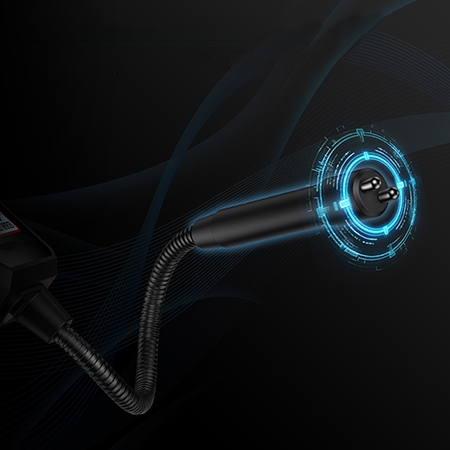
High-Sensitivity Quick-Response Probe Ensures Accurate and Stable Detection
- High-Sensitivity Probe: Equipped with advanced sensors, the probe quickly detects moisture levels in brake fluid, providing fast and reliable results.
- Accurate Measurements: The sensitive probe ensures precise readings even when water content is minimal, reducing false alarms or errors.
Quick Response: Provides almost instantaneous feedback, allowing multiple vehicles or samples to be tested efficiently. - Durable Construction: The probe is designed to withstand repeated use and exposure to brake fluid without degradation, ensuring long-lasting performance.
- User-Friendly: Easy to operate with a simple dip-and-read method, making it convenient for both professional mechanics and car owners.
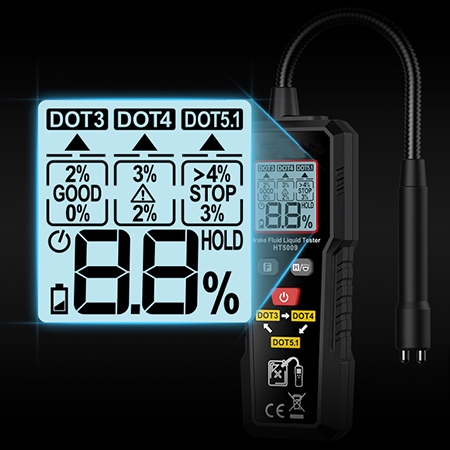
High-Resolution Backlit Screen for Clear Readings
- High-Resolution Display: Shows clear and precise test results, making it easy to read at a glance.
- Visible in All Conditions: Backlit screen ensures readability in low-light conditions, such as at night, and remains clear under bright sunlight.
- Quick Result Feedback: The screen instantly displays the test outcome, reducing waiting time and improving efficiency.
- User-Friendly Interface: Clear digital readout or LED indicators simplify operation, even for first-time users.
- Durable and Reliable: The high-quality display is designed to withstand frequent use and resist scratches or smudges.
Dimension
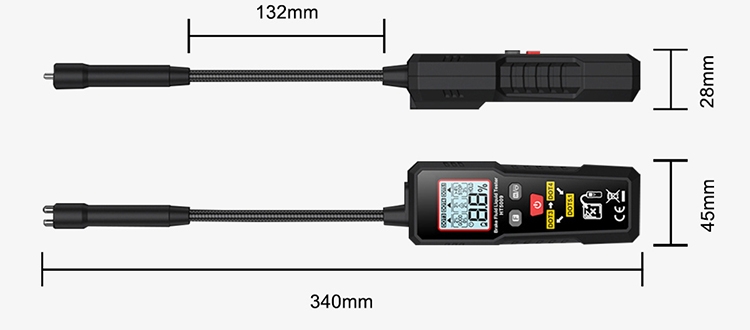
Applications
SISCO brake fluid tester is widely used in automotive workshops, inspection stations, fleet maintenance, and by car owners for routine vehicle care. It quickly detects moisture content or boiling point changes in brake fluid, helping ensure reliable braking performance and compliance with DOT standards (DOT 3, DOT 4, DOT 5.1). This makes it an essential tool for mechanics, inspectors, and drivers to maintain safety and prevent brake failure.
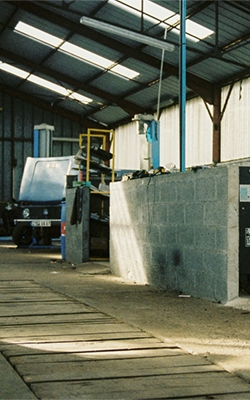
Inspection Stations
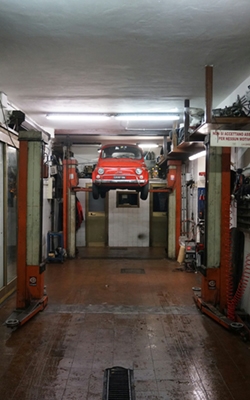
Fleet Maintenance

Automotive Workshops

Routine Vehicle Care
| Model | SISCO-BFT-HT5009 |
| Moisture Detection Range | 0%~4% |
| Resolution | 0.10% |
| Accuracy | ±0.3% |
| Brake Oil Type | DOT3, DOT4, DOT5.1 |
| Display | LCD display |
| Power Supply | 2. 1.5V AAA batteries (not included) |
| Operating Temperature | -20~60℃ |
| Dimensions | 340*45*28mm |
| Weight | 100g |
| Low Battery Indication | √ |
| Trichromatic Backlight | √ |
| Flashlight | √ |
| Auto Shutoff | √ |
| Battery Low Voltage Indicator | √ |
| Buzzer Alert | √ |
Q1: What is a brake fluid tester?
A1: A brake fluid tester is a tool used to check the condition of brake fluid in a vehicle. It measures factors like water content or boiling point, since moisture in brake fluid lowers its effectiveness and can lead to brake failure. By providing a quick pass/fail or percentage reading, it helps determine whether the brake fluid is safe to use or needs to be replaced.
Q2: What types of brake fluid can a brake fluid tester test?
A2: Most brake fluid testers are designed to test glycol-based fluids, including DOT 3, DOT 4, and DOT 5.1. These are the most common types used in passenger cars and light trucks. They are not suitable for DOT 5 silicone-based brake fluid, which requires different testing methods.
Q3: How does a brake fluid tester work?
A3: A common brake fluid tester works by submerging its electrodes into the brake fluid, then measuring the electrical conductivity of the fluid. Because brake fluid naturally absorbs water over time, this water increases its conductivity. The tester uses a traffic light system of LEDs to indicate the percentage of water content and the overall condition of the fluid, with green meaning no water and red indicating a high level of moisture that requires a brake fluid flush.
Tips: Why is water content in brake fluid dangerous?
Excess water in brake fluid is one of the hidden dangers that can seriously compromise driving safety. Because brake fluid is hygroscopic, it gradually absorbs moisture from the air over time. This contamination lowers the fluid’s boiling point, making it more likely to vaporize during intense braking, which can lead to brake fade, a spongy pedal feel, or even complete brake failure. At the same time, moisture accelerates rust and corrosion inside brake lines, calipers, and other key components, increasing the risk of costly repairs. By regularly checking the water content with a brake fluid tester, drivers can ensure their braking system remains responsive, reliable, and safe under all driving conditions.
Thank you for buying industrial test and measurement equipment on SISCO.com, all products sold by SISCO and the partner cover a 12 months warranty, effective from the date of receiving the products.
What is covered?
SISCO is responsible for providing free spare parts, and free technical support to assist the customer to repair the defective products until the problem is solved.
What is not covered?
- Product purchased from anyone other than a SISCO store or a SISCO authorized reseller.
- Expendable parts.
- Routine cleaning or normal cosmetic and mechanical wear.
- Damage from misuse, abuse or neglect.
- Damage from use of parts other than SISCO approved.
- Damage from use outside the product’s usage or storage parameters.
- Damage from use of parts not sold by SISCO.
- Damage from modification or incorporation into other products.
- Damage from repair or replacement of warranted parts by a service provider other than a SISCO authorized service provider.
- Damage caused by the application environment not meeting the product usage requirements and the failure to perform preventive maintenance.

